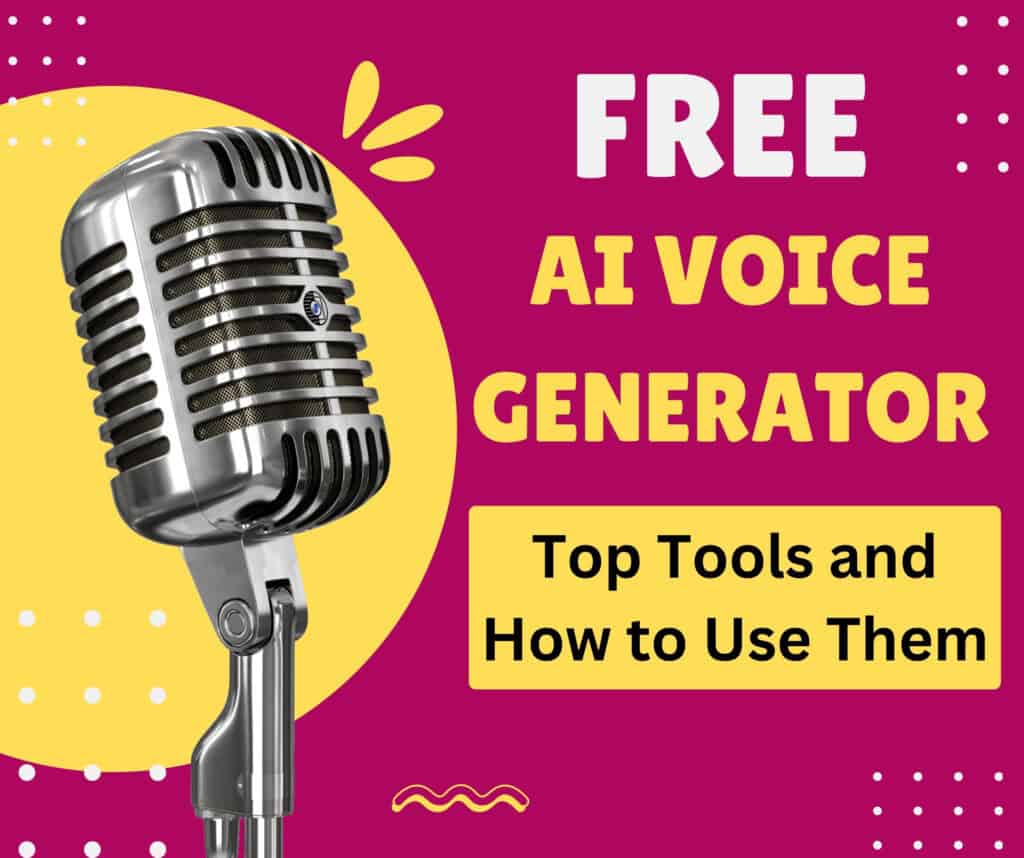In recent years, advancements in artificial intelligence have transformed many areas of technology, and voice generation is no exception. AI voice generation, also known as text-to-speech (TTS), involves using sophisticated algorithms and neural networks to convert written text into spoken words. This technology has made significant strides, enabling machines to produce human-like speech with impressive accuracy and naturalness.
The growing popularity of AI voice generation is a testament to its versatility and effectiveness. Whether for creating engaging content, developing interactive applications, or enhancing accessibility, AI voice generators are becoming indispensable tools in various fields. They provide a cost-effective and efficient way to produce high-quality voiceovers without the need for professional voice actors or expensive recording equipment.
Start your journey to financial freedom today. Click below!
Try Wealthy Affiliate (For Free).
For many users, especially those on a budget, free AI voice generators offer a valuable solution. These tools allow individuals and organizations to harness the power of advanced voice synthesis technology without incurring significant expenses. Here’s why free AI voice generators are particularly important:
- Content Creation: Content creators, including bloggers, YouTubers, and podcasters, can use free AI voice generators to add voiceovers to their projects. This can enhance the quality of their content, make it more engaging, and help in reaching a broader audience.
- Marketing: In the world of digital marketing, having a strong auditory component can make campaigns more memorable. Free AI voice generators enable marketers to create promotional materials, advertisements, and interactive content without the high costs associated with professional voiceover services.
- Education: Educators and e-learning developers can use these tools to create instructional materials, narrated presentations, and interactive lessons. By providing voiceovers for educational content, they can make learning more accessible and engaging for students.
What is a Free AI Voice Generator?
Definition and Basic Functionality
A free AI voice generator is a software tool that uses artificial intelligence to convert written text into spoken words, often with a lifelike and natural-sounding voice. These tools are accessible at no cost, making them an attractive option for individuals and businesses seeking to add voice to their projects without a financial investment.
At its core, a free AI voice generator allows users to input text—whether it’s a script, article, or any written content—and receive an audio file in return. The generated voice can vary in tone, pitch, speed, and accent, depending on the capabilities of the tool. Most free AI voice generators offer a range of voices to choose from, enabling users to select one that best fits their needs.
How AI Voice Generators Work
AI voice generators operate through a series of complex processes that involve machine learning and natural language processing. Here’s a simplified overview of how they work:
- Text Input: The user provides the text they want to be spoken. This could be anything from a single sentence to a long document.
- Text Analysis: The AI system analyzes the text to understand its structure, punctuation, and context. This step is crucial for generating natural-sounding speech.
- Phoneme Conversion: The text is converted into phonemes, which are the distinct units of sound in speech. This process involves breaking down the text into its basic sounds.
- Speech Synthesis: Using a neural network or other advanced algorithms, the AI synthesizes the phonemes into speech. This involves selecting the appropriate voice characteristics and combining them to produce a cohesive audio output.
- Voice Output: The final step is to generate the spoken voice based on the synthesized speech. The result is an audio file that can be played back or embedded into various media.
The Evolution of Text-to-Speech Technology
Text-to-speech (TTS) technology has come a long way since its inception. Here’s a brief look at its evolution:
- Early Beginnings: The first TTS systems were rudimentary and produced robotic-sounding voices. These early systems were limited in their ability to handle complex speech patterns and lacked naturalness.
- Rule-Based Systems: As technology advanced, rule-based systems were developed, which used predefined rules to convert text into speech. These systems improved pronunciation and intonation but were still somewhat mechanical.
- Statistical Models: The introduction of statistical models brought significant improvements. These models used large datasets to learn and predict how words should be spoken, resulting in more natural-sounding speech.
- Neural Networks and Deep Learning: The most recent advancements involve neural networks and deep learning techniques. These technologies enable AI voice generators to produce highly realistic and human-like speech by learning from vast amounts of data and mimicking natural speech patterns.
- Current Capabilities: Today’s AI voice generators offer a wide range of voices, accents, and languages. They are capable of producing speech that closely resembles human intonation and emotion, making them suitable for various applications, from audiobooks to virtual assistants.
Benefits of Using a Free AI Voice Generator
Cost-Effective Solution for Voiceovers
One of the most significant advantages of using a free AI voice generator is its cost-effectiveness. Traditionally, professional voiceovers can be expensive, involving fees for voice talent, studio time, and production. For individuals or small businesses operating on a tight budget, these costs can be prohibitive. Free AI voice generators eliminate the need for these expenses, providing a high-quality alternative without the financial burden. This is particularly valuable for startups, content creators, and educators who need to produce voiceovers regularly but want to keep costs low.
Affiliate Disclosure: Some of the links in this post are affiliate links, meaning I may earn a commission if you make a purchase. However, these links provide access to essential resources for your online success.
Try Wealthy Affiliate (For Free).
Time-Saving in Content Creation
Creating high-quality voiceovers traditionally requires considerable time and effort. It involves scripting, recording, editing, and often re-recording to achieve the desired result. With a free AI voice generator, much of this process is streamlined. Users can quickly input their text and generate voiceovers with minimal manual intervention. This efficiency is crucial for content creators who need to produce large volumes of material or meet tight deadlines. By reducing the time spent on voice production, users can focus more on other aspects of their projects, such as content strategy and audience engagement.
Access to Multiple Voices and Languages
Free AI voice generators often provide a diverse range of voice options and language support. Users can choose from various accents, genders, and vocal tones to best match their project’s needs. This versatility is especially beneficial for creating content that caters to different demographics or regions. For instance, a marketing campaign targeting a global audience can leverage different languages and accents to resonate with various cultural groups. Additionally, the ability to select different voices allows users to personalize their content and maintain consistency across different types of media.
Enhances Accessibility and User Engagement
AI voice generators play a crucial role in enhancing accessibility. For individuals with visual impairments or reading difficulties, having content available in an audible format can make information more accessible and inclusive. This is particularly important in educational settings, where students with different learning needs can benefit from spoken materials.
Moreover, incorporating voiceovers into digital content can significantly boost user engagement. Audio elements can make content more dynamic and interactive, capturing the audience’s attention and enhancing their experience. For example, an instructional video with a clear and engaging voiceover can improve comprehension and retention compared to text-only content. Additionally, voiceovers can add a professional touch to presentations, advertisements, and online courses, making them more appealing and effective.
Top Free AI Voice Generators to Try
There are several free AI voice generators available that cater to different needs and preferences. Here’s a look at some of the top tools, including their key features, pros, and cons:
– Tool 1: Google Text-to-Speech
Overview: Google Text-to-Speech is a widely used tool that integrates seamlessly with various Google services and applications. It converts text into natural-sounding speech using Google’s advanced machine learning technology.
Key Features:
- High-quality voice output with natural intonation.
- Support for multiple languages and accents.
- Easy integration with Google products like Google Translate and Google Assistant.
Pros:
- Reliable and consistent voice quality.
- Access to a broad range of languages and dialects.
- Integration with other Google services enhances usability.
Cons:
- Limited customization options for voice modulation.
- Requires a Google account for full functionality.
- May have some limitations in terms of advanced features compared to paid options.
– Tool 2: Amazon Polly
Overview: Amazon Polly is a cloud-based AI voice generator that converts text into lifelike speech. It is known for its realistic voice output and is part of Amazon Web Services (AWS).
Key Features:
- Wide selection of voices and languages, including regional accents.
- Ability to adjust speech rate and pitch.
- Supports SSML (Speech Synthesis Markup Language) for advanced control over speech output.
Pros:
- High-quality, human-like voices.
- Flexibility with voice adjustments and SSML support.
- Integration with AWS services for scalability and additional features.
Cons:
- Requires an AWS account, which may be a barrier for some users.
- Free tier has usage limits, with charges for higher usage.
- The interface can be complex for beginners.
– Tool 3: IBM Watson Text to Speech
Overview: IBM Watson Text to Speech is a powerful AI-driven tool that offers high-quality voice synthesis with a focus on natural and expressive speech. It is part of IBM’s suite of AI services.
Key Features:
- Extensive selection of voices and languages.
- Real-time speech generation with low latency.
- Customizable voice models for specific applications.
Pros:
- Realistic and expressive voice synthesis.
- Customization options for unique voice requirements.
- Free tier available with a generous usage limit.
Cons:
- Some advanced features are limited to paid plans.
- The setup process can be intricate for new users.
- May require integration with other IBM services for full functionality.
– Tool 4: Natural Reader
Overview: Natural Reader is a user-friendly AI voice generator that offers both online and downloadable versions. It provides high-quality voice output for various types of content.
Key Features:
- Easy-to-use interface with drag-and-drop functionality.
- Supports multiple file formats, including PDFs and Word documents.
- Offers a range of voices and languages.
Pros:
- Intuitive and accessible for users of all skill levels.
- Supports a variety of document types.
- Free version includes essential features with no registration required.
Cons:
- The free version has limited voice options compared to the premium plan.
- Fewer advanced customization features than some competitors.
- Free version may include watermarks or ads.
– Tool 5: Balabolka
Overview: Balabolka is a versatile, free text-to-speech application for Windows that supports a variety of file formats and voice engines. It is known for its flexibility and range of customization options.
Key Features:
- Supports multiple file formats, including TXT, DOCX, and EPUB.
- Integration with various TTS engines and voice packs.
- Customizable speech settings, such as pitch, rate, and volume.
Pros:
- Highly customizable with a broad range of settings.
- Supports numerous TTS engines and voice packs.
- Free and open-source with regular updates.
Cons:
- The interface can be overwhelming for new users.
- Quality of voice output depends on the TTS engine used.
- Limited support for non-Windows operating systems.
How to Use a Free AI Voice Generator
Using a free AI voice generator is generally straightforward, but following a few key steps can help you achieve the best results. Here’s a step-by-step guide on how to make the most of these tools:
Ready to break free from the 9-5? Start here!
Try Wealthy Affiliate (For Free).
1. Choosing the Right Tool for Your Needs
Before you start, it’s important to select the AI voice generator that best fits your requirements. Consider the following factors:
- Features: Look for features that match your needs, such as language support, voice options, and customization capabilities.
- Ease of Use: Choose a tool with an intuitive interface that suits your technical comfort level.
- Quality: Review examples or demos to ensure the voice output meets your expectations in terms of naturalness and clarity.
- Restrictions: Check if the tool has usage limits, watermarks, or other restrictions in its free version.
2. Entering Your Text or Script
Once you’ve chosen a tool, the next step is to input the text you want to convert into speech:
- Text Input Field: Locate the text input field or editor on the tool’s interface. This is where you’ll paste or type your text.
- Formatting: Ensure that your text is properly formatted. Some tools allow you to include punctuation, pauses, and emphasis to enhance the natural flow of speech.
- Preview: If the tool offers a preview feature, use it to check how your text will sound before generating the final audio.
3. Selecting a Voice and Language
Most AI voice generators offer a variety of voice options and languages. Here’s how to choose the right ones:
- Voice Selection: Browse through the available voices. You might find options based on gender, accent, or tone. Pick one that best fits the context of your project.
- Language: If your content is in a specific language, make sure the tool supports it. Some tools offer multiple languages and regional accents, so select the one that aligns with your audience.
- Voice Customization: Some tools allow further customization of the voice, such as adjusting pitch, speed, and volume. Explore these settings to fine-tune the output.
4. Generating and Downloading the Voice File
After configuring your settings, it’s time to generate and download your audio file:
- Generate Audio: Click the button to start the voice generation process. This may be labeled “Generate,” “Convert,” or something similar. The tool will process your text and create an audio file.
- Download: Once the audio is ready, there should be an option to download the file. This is usually in MP3 or WAV format. Save it to your device for use in your projects.
- Check Quality: Listen to the downloaded file to ensure it meets your quality expectations. If necessary, you can make adjustments and regenerate the file.
5. Tips for Getting the Best Results
To maximize the effectiveness of your AI voice generator, consider these tips:
- Clear Text: Use clear and concise text to avoid mispronunciations and ensure smooth speech generation. Avoid overly complex sentences or jargon.
- Proper Formatting: Incorporate appropriate punctuation and line breaks to guide the speech flow and enhance naturalness.
- Test Different Voices: Experiment with various voices and settings to find the one that best suits your content and audience.
- Regular Updates: Keep your tool updated to benefit from improvements and new features. Check for updates or new versions that may offer enhanced capabilities.
By following these steps, you can efficiently create high-quality voiceovers for a variety of projects, from educational materials to marketing content.
Applications of Free AI Voice Generators
Free AI voice generators have a wide range of applications across different fields. Their versatility makes them valuable tools for various purposes. Here’s a detailed look at some of the key use cases:
1. Content Creation (e.g., YouTube, Podcasts)
AI voice generators are increasingly popular among content creators looking to enhance their videos and audio content:
- YouTube Videos: Creators can use AI voice generators to add professional-quality voiceovers to their video content. This is particularly useful for explainer videos, tutorials, and commentary. The ability to choose from various voices and accents helps in tailoring the content to different audiences.
- Podcasts: For podcasters, AI voice generators offer a way to produce intros, outros, and supplementary audio segments without the need for studio equipment or voice talent. They can also be used to generate episodes quickly or to create alternative language versions of the podcast.
2. E-Learning and Educational Materials
In the education sector, AI voice generators play a significant role in making learning materials more engaging and accessible:
- Interactive Lessons: Educators can use AI voice generators to create interactive audio content for online courses. This includes narrated presentations, quizzes, and educational modules that help in maintaining student engagement and improving comprehension.
- Audiobooks and Study Aids: Textbooks and study guides can be converted into audiobooks, allowing students to listen to their materials on the go. This is especially beneficial for students with learning disabilities or those who prefer auditory learning.
3. Marketing and Advertising
In marketing and advertising, AI voice generators help in creating compelling audio content that can boost brand visibility and engagement:
- Voiceovers for Ads: Marketers can use AI voice generators to produce voiceovers for advertisements, including radio spots and video ads. This helps in delivering consistent messaging and maintaining brand voice across different platforms.
- Product Demos and Tutorials: AI-generated voices can be used to narrate product demonstrations and tutorials, providing clear and professional explanations that enhance customer understanding and interest.
4. Accessibility Features for Websites and Apps
AI voice generators improve accessibility for users with visual impairments or other disabilities:
- Website Readability: Adding text-to-speech functionality to websites allows users to have content read aloud to them, making it easier for those with visual impairments or reading difficulties to access information.
- App Integration: Mobile apps can incorporate AI-generated voices for features like voice commands, in-app guidance, and audio feedback, enhancing usability for all users, especially those with disabilities.
5. Personal Projects and Creative Endeavors
For personal use and creative projects, AI voice generators offer a flexible and cost-effective solution:
- Creative Writing: Writers and hobbyists can use AI voice generators to bring their stories or scripts to life by creating voiceovers for short films, animations, or audio dramas.
- Custom Greetings and Messages: AI-generated voices can be used to create custom voicemail greetings, personal messages, or announcements for events and celebrations.
- Language Learning: Language learners can use AI voice generators to practice pronunciation and listen to spoken examples of vocabulary and phrases in different languages.
In summary, the applications of free AI voice generators are diverse and impactful. They provide valuable solutions for content creation, education, marketing, accessibility, and personal projects, making them versatile tools for a wide range of uses.
Launch your online career today. Click below!
Try Wealthy Affiliate (For Free).
Limitations and Considerations
While free AI voice generators offer valuable tools for various applications, there are several limitations and considerations to be aware of. Understanding these aspects can help users make informed decisions and address potential issues effectively.
1. Quality Differences Between Free and Paid Versions
Free AI voice generators often come with limitations compared to their paid counterparts:
- Voice Quality: Free versions may have lower-quality voice outputs compared to paid versions. Paid tools typically offer more natural, human-like voices with better intonation and clarity. The range of available voices and their customization options can also be more limited in free versions.
- Features and Customization: Advanced features such as fine-tuning of pitch, speed, and emotional tone might be restricted in free versions. Paid versions often provide more extensive control over these parameters, allowing for more tailored and professional results.
- Usage Limits: Free tools may impose restrictions on the amount of text that can be converted or the number of voiceovers that can be generated within a given period. Paid versions usually offer higher or unlimited usage limits, making them suitable for larger-scale projects.
2. Ethical Considerations (e.g., Deepfakes, Misuse)
The use of AI voice generators raises several ethical concerns:
- Deepfakes: AI-generated voices can be used to create deepfakes—audio recordings that impersonate someone’s voice without their consent. This can lead to misinformation, identity theft, and other malicious activities. It’s crucial to use AI voice generators responsibly and ensure that content is not used to deceive or harm others.
- Misuse: AI voice technology can be misused for fraudulent purposes, such as creating fake voice messages for scams or impersonating individuals in sensitive contexts. Users should be aware of the ethical implications and legal boundaries associated with voice generation technology.
3. Privacy Concerns When Using Online Tools
When using online AI voice generators, privacy is a significant concern:
- Data Security: Many free AI voice generators operate on cloud-based platforms, which means that your text and generated audio may be stored on remote servers. Ensure that the tool you use has robust data protection measures and privacy policies in place.
- Personal Information: Be cautious about entering sensitive or personal information into online tools. Even if a tool claims to have privacy protections, it’s wise to avoid sharing confidential or personal data.
4. Potential Technical Issues and How to Troubleshoot Them
Users may encounter technical issues while using AI voice generators. Here are some common problems and troubleshooting tips:
- Poor Audio Quality: If the generated voice sounds unnatural or has noticeable distortions, try adjusting the text formatting or experimenting with different voices and settings. Ensure that the text is clear and properly punctuated to improve speech output.
- Compatibility Issues: Some tools may not work well on all devices or browsers. Make sure you are using a compatible browser or operating system. If issues persist, try clearing your browser cache or using an alternative browser.
- Slow Processing Times: If the tool is taking too long to generate audio, it could be due to high demand or server issues. Try using the tool during off-peak hours or consider switching to a different tool if the problem continues.
- Error Messages: If you encounter error messages or functionality issues, check the tool’s support resources or forums for troubleshooting advice. Many tools have user guides or FAQs that can help resolve common problems.
Conclusion
As we’ve explored, free AI voice generators offer a range of capabilities and benefits that can significantly enhance various projects and applications. Here’s a recap of the key points discussed:
- Understanding AI Voice Generators: We delved into what AI voice generators are, how they function, and their evolution from basic text-to-speech systems to sophisticated, natural-sounding voices. These tools leverage advancements in machine learning to provide high-quality speech output from text.
- Benefits of Free AI Voice Generators: We highlighted several advantages, including their cost-effectiveness, time-saving qualities, and the wide range of voices and languages available. These features make them a valuable resource for content creation, e-learning, marketing, and enhancing accessibility.
- Top Free AI Voice Generators: We reviewed some of the top free tools available, providing insights into their features, pros, and cons. This overview can help you choose the right tool for your needs, whether for personal projects or professional use.
- How to Use a Free AI Voice Generator: We outlined a step-by-step guide on using these tools, from choosing the right one to generating and downloading your audio file. Tips for achieving the best results were also provided to help you maximize the effectiveness of these tools.
- Limitations and Considerations: We discussed the limitations of free AI voice generators, including quality differences, ethical concerns, privacy issues, and potential technical problems. Being aware of these factors can help you navigate the use of these tools more effectively and responsibly.
In conclusion, free AI voice generators represent a powerful and accessible resource for a wide array of applications. They offer an opportunity to enhance and streamline various tasks, from creating engaging content to making information more accessible. As AI technology continues to advance, these tools are likely to become even more sophisticated, offering greater customization, improved voice quality, and broader applications.
I encourage you to explore and experiment with different free AI voice generators to find the one that best meets your needs. Whether you’re a content creator, educator, marketer, or simply someone interested in innovative technology, these tools provide a valuable way to integrate professional-quality voiceovers into your projects.
Ready to create your own wealth? Click to begin
Try Wealthy Affiliate (For Free).
As we look to the future, the potential of AI in voice technology is exciting. Innovations in AI and machine learning are expected to drive further advancements in voice generation, making it possible to create even more natural and nuanced speech. Stay curious and engaged with these developments to fully leverage the evolving capabilities of AI voice technology.
We’d love to hear from you! Have you used any free AI voice generators? What has been your experience with them? Do you have any questions or tips to share? Drop a comment below and join the conversation. Your feedback and insights can help others discover the best tools and make the most of this exciting technology. Feel free to share your thoughts or ask any questions you might have—we’re here to help!








Wonderful web site Lots of useful info here Im sending it to a few friends ans additionally sharing in delicious And obviously thanks to your effort